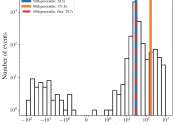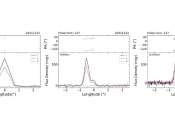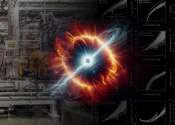The neutron is a subatomic hadron particle which has the symbol n or n0, no net electric charge and a mass slightly larger than that of a proton. With the exception of hydrogen, nuclei of atoms consist of protons and neutrons, which are therefore collectively referred to as nucleons. The number of protons in a nucleus is the atomic number and defines the type of element the atom forms. Neutrons are necessary within an atomic nucleus as they bind with protons via the strong force; protons are unable to bind with each other due to their mutual electromagnetic repulsion being stronger than the attraction of the strong force. The number of neutrons is the neutron number and determines the isotope of an element. For example, the abundant carbon-12 isotope has 6 protons and 6 neutrons, while the very rare radioactive carbon-14 isotope has 6 protons and 8 neutrons.
While bound neutrons in stable nuclei are stable, free neutrons are unstable; they undergo beta decay with a mean lifetime of just under 15 minutes (881.5±1.5 s). Free neutrons are produced in nuclear fission and fusion. Dedicated neutron sources like research reactors and spallation sources produce free neutrons for use in irradiation and in neutron scattering experiments. Even though it is not a chemical element, the free neutron is sometimes included in tables of nuclides. It is then considered to have an atomic number of zero and a mass number of one, and is sometimes referred to as neutronium.[citation needed]
The neutron has been the key to nuclear power production. After the neutron was discovered in 1932, it was realized in 1933 that it might mediate a nuclear chain reaction. In the 1930s, neutrons were used to produce many different types of nuclear transmutations. When nuclear fission was discovered in 1938, it was soon realized that this might be the mechanism to produce the neutrons for the chain reaction, if the process also produced neutrons, and this was proven in 1939, making the path to nuclear power production evident. These events and findings led directly to the first man-made nuclear chain reaction which was self-sustaining (Chicago Pile-1, 1942) and to the first nuclear weapons (1945).









